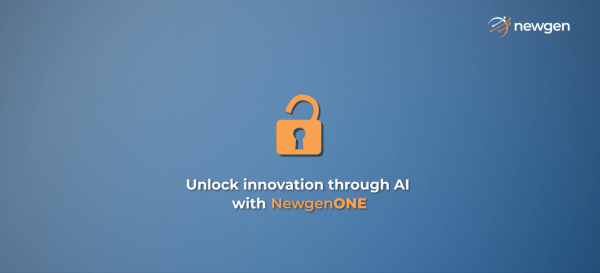“With Newgen’s AI-powered solutions for insurance, we optimized document storage, leading to substantial savings in claims processes. Our operational spend reduced through end-to-end automation.”
– VP, US Fortune 500 P&C Insurer
Personalize insurance journeys through real-time support, end-to-end agentic automation
NewgenONE AI Agents leverage our low-code foundation to unify data, guide intelligent decisions, and execute actions seamlessly within your insurance workflows. They drive smarter outcomes across every insurance journey.

Learn What Newgen Insurance Solutions Can Do For You
Life & Annuity Insurance
Bring the power of unified automation to customer journeys, from underwriting and policy servicing to claims management and distribution.
Learn More >Property and Casualty Insurance
Modernize underwriting, policy binding, and claims for P&C insurance with accurate data-based decision-making.
Learn More >Specialty Insurance
Leverage the rules management engine, product configuration, unified dashboards, and end-to-end process automation to boost efficiency.
Learn More >Digital Distribution
Drive agent success with digital onboarding, accurate performance insights, and dynamic compensation.
Learn More >Service Request Management
Elevate customer satisfaction and productivity with AI-led proactive servicing and real-time resolution of requests.
Learn More >Insurance WorkDesk
Unify content workflows for submissions, risk prioritization, policy generation, and claims settlement using a single pane of glass.
Learn More >Agentic Workspaces for Insurers
Leverage a multi-agent framework with purpose-built AI agents for core insurance journeys like underwriting, claims, and policy servicing. Built on a low-code foundation, it integrates seamlessly with legacy and digital systems to deliver real-time insights, contextual recommendations, and pattern-aware automation.

Core Capabilities of Newgen’s Solutions for Insurance
Intelligent Underwriting
Orchestrate workflows for automated submissions, with faster and more accurate underwriting.
AI-led Claims and Service
Automate first notice of loss, document intake, and fraud detection. Ensure complexity-based claims triaging and assignment.
Smart Policy Servicing
Experience dynamic clause and template creation, and swift contract generation with an advanced policy management system.
Key Benefits
- Higher profitability due to enhanced productivity, reduced churn, and optimized cross-selling opportunities
- Reduce underwriting complexities and administrative burden through segmentation of underwriting requirements and straight-through processing
- Improve claims effectiveness through structured and unstructured content insight across intake, verification, adjustment, payment, and service
- Dynamic collaboration with your digital ecosystem and support partners for faster processes and a unified customer experience
- Assure adherence to global compliance regulations to mitigate business risks

Find Your Winning Strategy with Newgen
See how Newgen’s low-code platform is transforming the insurance industry. Request a demo to explore our insurance-specific solutions.
Request a demoGot Questions?
Enter your information, and a Newgen representative will be in touch shortly.
Frequently Asked Questions
Newgen’s AI-first comprehensive insurance solutions enable insurers to achieve faster time-to-market, improve accuracy and compliance, and deliver a unified omnichannel experience across life, health, and general insurance, to ensure superior customer engagement.
Policyholders today expect fast, seamless, and personalized insurance experiences that can be accessed anytime, anywhere. Newgen’s AI-first, low-code platform and purpose-built insurance accelerators help insurers deliver personalized, seamless customer journeys.
Newgen’s AI-first low-code platform, tightly integrated with advanced AI/ML, helps digitize insurance operations through end-to-end automation and centralization of processes, including policy underwriting, policy servicing, and claims processing.
Newgen’s Intelligent Underwriting Solution enables simplified and secure case assessment by analyzing incoming applications and automatically highlighting areas of concern to increase underwriter productivity and accuracy.
Newgen’s Intelligent Underwriting Solution can expedite the quotation process with auto-classification of proposals as straight-through or near straight-through and verification and validation features, including duplicity checks, anti-money laundering, fraud detection, and blacklisting.
This helps achieve faster issuance, reduce operational cost, enhance customer service, and minimize data entry, while maintaining compliance.
The Underwriting Assistant AI Agent helps assess risk by analyzing historical data, risk profiles, and benchmarks using the Risk Prediction model. The model streamlines processing, determines policies needing review, and enables data-driven decisions on terms, pricing, and risk exposure reduction.
Yes, Newgen’s Early Claim Probability AI Agent leverages our purpose-built AI Agent to automate life insurance underwriting with predictive mortality risk scoring, intelligent routing, explainable AI, and reasoning-led decisioning. It also helps predict five-year mortality likelihood using test results and health history.
Newgen’s Claims Management Solution streamlines the entire claim lifecycle, from first notice of loss (FNOL) to settlement, recovery, and closure. It boosts efficiency and reduces fraud by automating manual processes.
Newgen’s Claims Management Solution uses the Fraud Pattern Analysis Model for Claims to analyze claim-filing behavior, historical discrepancies, and external red-flag signals (e.g., duplicate beneficiaries, sudden policy upgrades before death) to detect potential fraud.
Additionally, an Intelligent Fraud Detection & Prevention Model identifies fraudulent claims by analyzing claim frequency, repair shop history, and geospatial anomalies.
Yes, the Auto-adjudication of Low-risk Claims model uses natural language processing (NLP) and business rule engines to instantly approve low-risk claims, such as daycare procedures or minor hospitalization events, based on treatment codes and past claim history.
The Property Damage Assessment Model leverages AI and geo-spatial data to assess property damage post-disaster, automating claim categorization, repair cost estimation, and surveyor dispatch.
Newgen’s Policy Servicing Solution automates the entire customer service request lifecycle. It opens up new channels for registering customer queries and ensures faster responses.
The Churn Risk Prediction & Retention Enablement feature of the AI Agent for Policy Servicing proactively identifies policyholders with a probability of lapse using AI models trained on policy, payment, and health data, empowering insurers to trigger timely retention campaigns and boost renewal rates.
Newgen’s Bancassurance Solution eliminates switching between applications to generate different quotations, proposals, policies, etc.. Bankers can access policies from multiple insurance partners/organizations on a single login window.

